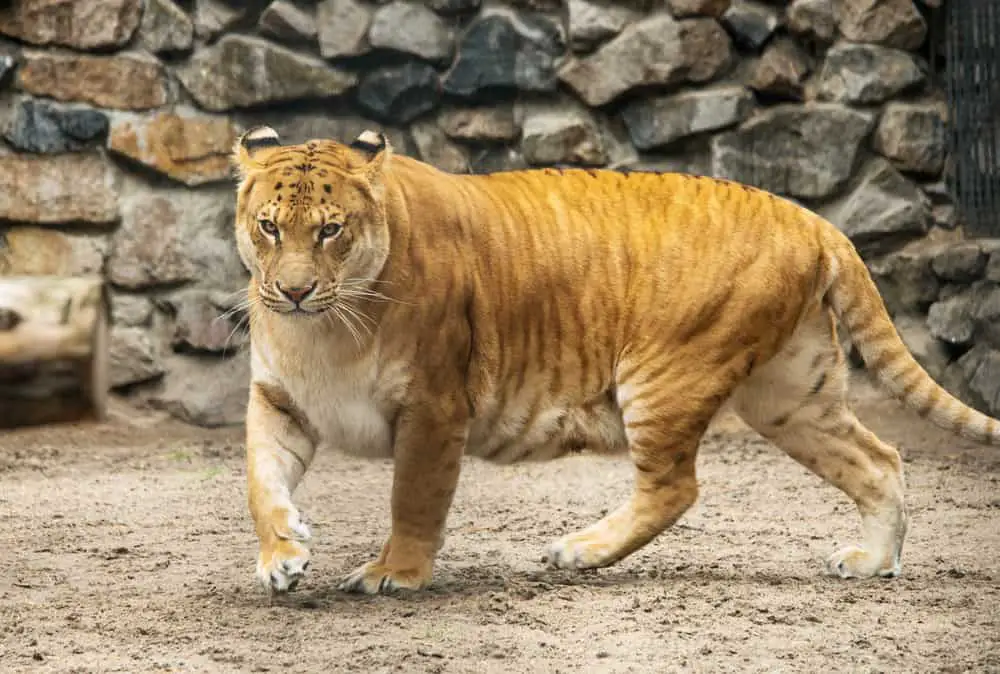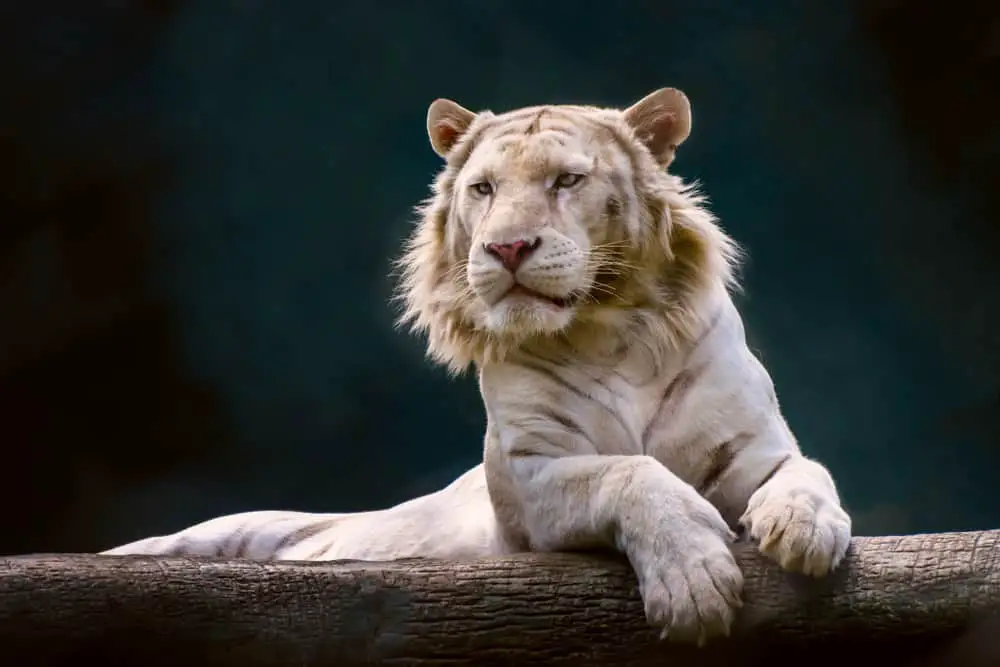The liger is a rare species of big cat, which has been the subject of increased fascination in recent years. It is most widely known as being a hybrid between a lion and a tigress, created through artificial selection methods. This article aims to provide an overview of the history, biology, and conservation efforts related to this unique feline species.
A brief overview of the origin of ligers can be used to trace back their genetic roots. The first recorded instance of liger creation dates back to the early 19th century when several captive lions and tigers were bred together in India by British officers.
Subsequently, ligers have become increasingly popular attractions at zoos around the world due to their large size and distinct physical characteristics. They typically grow larger than either parent species with males reaching up to 3 meters in length and weighing over 400 kilograms.
Understanding how these animals interact within various ecosystems is also essential for developing effective conservation strategies for them.
Ligers are solitary creatures that prefer grassy plains or savannas but are not limited solely to those habitats; they can also inhabit tropical rainforests or even arid deserts depending on availability of food sources such as wildebeest, antelopes, rodents, etc. In order to protect against human encroachment upon their habitat and potential poaching incidents, numerous organizations have implemented breeding programs dedicated exclusively to maintaining healthy populations of ligers worldwide.

Definition
A liger is a hybrid animal which results from the mating of a male lion (Panthera leo) and a female tiger (Panthera tigris). It is primarily found in captivity, as the geographical range of the two species does not overlap in the wild. Ligers have been documented in zoos since at least 1825. The term ‘liger’ was first used by French naturalist Georges-Louis Leclerc, Comte de Buffon, in 1768 to describe his observations of hybrids between lions and tigers.
The characteristics of ligers can vary greatly depending on their parents’ genes. Generally speaking, they are larger than either parent species with males weighing up to 900 kg and females reaching 450 kg.
They typically grow much faster than either lions or tigers, maturing earlier and living longer than both of them. Their coloration ranges from golden yellow to pale orange; some may display stripes while others do not. Other physical features include an elongated body shape similar to that seen in tigers, along with tufted ears like those found on lions.
Ligers thrive best when housed together in large enclosures providing plenty of space for movement and hiding places for resting areas away from public view. Such spaces should be designed taking into consideration the needs of each individual liger – socialization opportunities, enrichment activities, dietary requirements etc., all need to be taken into account for optimal wellbeing outcomes for these fascinating animals.
History
The origin of the liger is an ancient one, steeped in legendary stories and folklore. While its exact beginning remains unknown, historians believe that cross-breeding between a lion and tiger likely began thousands of years ago.
This form of hybridization was not uncommon among these two species as they were found living side by side in many parts of Asia. Ancient stories told by local people often described sightings of animals with traits from both lions and tigers.
Over time, descriptions of ligers spread throughout the world. As more details regarding their physical characteristics became known, interest grew in understanding how this peculiar animal came to be.
By the 19th century, zoologists had conducted experiments to confirm suspicions about the origins of this powerful creature, ultimately leading them to discover what we now know today: that ligers are created through successful breeding between a male lion and female tiger.
In modern times, knowledge surrounding the liger has expanded significantly due to advances in science and technology. More studies have been done on its behavior and habits, providing us with greater insight into this fascinating animal’s existence. The result is a unique appreciation for all aspects of the liger which can be seen around the globe today.
Physical Characteristics
Ligers are among the world’s largest cats. They have a unique physical appearance, combining traits from their lion and tiger parents. The most prominent feature of ligers is their mane, which runs along the back to the tail; it is more pronounced in male than female ligers. Ligers also possess stripes like tigers, though they tend to be lighter colored than those on tigers. In addition, they often display long whiskers and claws similar to lions.
The size of ligers varies depending upon the type of cat that each parent was before mating. Typically, males weigh up to 900 pounds while females range between 400-500 pounds. Their height can reach over 10 feet when standing upright with its hind legs fully extended upwards. Furthermore, ligers can live for as many as twenty years in captivity due to proper care and nutrition by experts/breeders/zookeepers who specialize in caring for them.
Overall, liger cubs are born with distinctive features inherited from both parent species such as a large head with small ears, powerful jaws, tufted tails and strong limbs equipped with sharp retractable claws specifically designed for hunting prey animals like deer or wild boar in their natural habitat. Consequently, these remarkable big cats exhibit extraordinary physical characteristics not found anywhere else in nature except within this hybrid breed – making them truly one of a kind creatures!
Habitat And Distribution
Ligers are found in the wild primarily across eastern and southern Asia, including areas of India, Bangladesh, China and Russia. They occupy a range of habitats within this region – forests, grasslands, riverside thickets, wetlands and mountains up to 4500 metres above sea level.
In addition to its natural habitat, they also inhabit regions that have been modified by humans such as agricultural fields and plantations. The distribution pattern is influenced mainly by their need for abundant prey availability and places with suitable cover from predators.
The presence of human activities has led to habitat loss for ligers due to deforestation resulting in fragmentation or destruction of their home ranges. This has resulted in reduced food sources leading to poor health and mortality among these animals. As a result there has been an increase in population decline rates over recent years which needs immediate attention from conservationists if the liger species is to survive into the future.
Range expansion through re-wilding programmes could offer some hope for the survival of the liger species by providing new opportunities for them to roam freely without any disruption from human activities whilst still being able to access appropriate resources needed for healthy living conditions and reproduction. Such projects require careful planning with long term outcomes monitored closely so that effective mitigation strategies can be implemented where required.
Diet And Nutrition
Ligers have unique dietary needs that must be taken into consideration when caring for them. As a carnivorous species, their diet consists primarily of meat and other animal products. In the wild, ligers will select prey based on availability as well as nutritional needs.
The food intake of a liger should consist of:
- Animal proteins: such as poultry, beef, fish, eggs or game birds
- Vegetables & Fruits: including leafy greens, carrots, apples and melons
- Supplements: vitamins and minerals to supplement any nutrient deficiencies in their diet
Nutritional requirements vary depending upon the age and health status of an individual liger. Many experts recommend formulating diets specifically tailored to meet the individual needs of each liger.
Additionally, it is important to ensure proper absorption of nutrients in order to promote optimal health. This can be achieved by providing ample amounts of fresh water along with appropriate supplementation if necessary. With careful planning and attention to detail, owners can create healthy diets that provide all essential nutrients required by their pet liger.
By properly accounting for food intake and ensuring adequate nutrition through balanced meals, owners are able to fulfill their responsibility toward maintaining excellent overall health for their liger companion.
Reproduction
The reproductive behavior of the liger is quite fascinating. With regards to breeding, ligers are capable of mating with either a lion or tiger, depending on the gender composition of the two animals. The male liger will typically mate with a female tiger and vice versa for the female liger. This is due to their larger size as compared to lions and tigers, thus making them less likely to be aggressive during mating season.
Mating behavior between ligers involves an elaborate courtship ritual that includes vocalization and body language cues from both sexes. In addition, the male may also display territorial marking behaviors such as scratching and scent-marking in order to assert dominance over his prospective mate. The gestation period for ligers averages about 105 days, after which time one to six cubs can be born at once.
Parental care among ligers is similar to other big cats; however it is important to note that they do not form traditional family units like some other species do. Instead, parenting duties are shared by both parents who continue providing protection and guidance until their cubs reach maturity. Once this stage has been achieved they are then fully independent members of their respective social groups within the wild population of ligers.

Conservation Status
The liger is classified as an endangered species due to its decreasing population in the wild. Conservation efforts are being made by various organizations, such as The Liger Preservation Foundation, and local governments to protect this species from extinction.
Habitat loss has been identified as one of the main causes for the decrease in population size of ligers. As their habitat continues to shrink, it becomes increasingly difficult for ligers to find suitable living space and food sources, leading them towards endangerment status.
To address this issue, conservationists have proposed several strategies that involve creating protected areas around forests where ligers inhabit, raising awareness about preserving natural habitats and ecosystems, and encouraging sustainable development practices near these reserves.
In addition to habitat loss threats, poaching prevention programs have also been put into place to help protect this animal species from illegal hunting activities. Captive breeding initiatives have also been implemented at wildlife centers worldwide in order to increase liger numbers through artificial reproduction methods.
These measures aim at maintaining genetic diversity within the existing population while providing a safety net against possible future extinctions caused by human activity or environmental changes.
Overall, there are many different approaches currently being taken in order to ensure that the liger populations remain stable over time. It is important for us all to be aware of these conservation efforts so that we can continue our fight for protecting these majestic animals for generations to come.
Conclusion
Ligers have captured the imagination of many, and their unique combination of characteristics make them a fascinating species. They are the largest existing feline in the world, living primarily in captivity due to their hybrid nature.
Despite this, they still require specialized care and attention to ensure optimal health and well-being throughout their lives. Although conservation efforts for these large cats remain limited, it is important that we continue to monitor liger populations and strive to protect any remaining natural habitats where possible.
This will help us to gain further insight into their behavior and ecology as well as provide crucial support for future generations of ligers. By doing so, we can better understand how best to manage this majestic species both currently and into the future.

